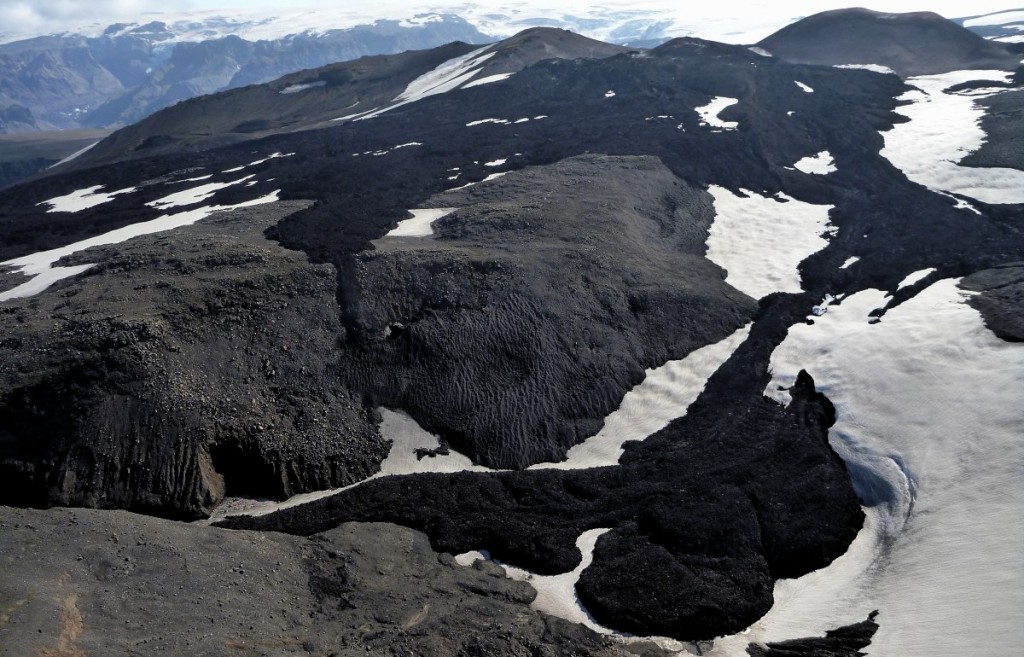This is a guest post by Dr Laura Kelly, a Lecturer in Microbiology at Manchester Metropolitan University, UK. It describes her study into the first microbial life to colonise the Fímmvörðuháls lava flow, Eyjafjallajökull, Iceland. Prof Charles Cockell of the UK Centre for Astrobiology in Edinburgh was also involved, and I helped out with a map and some volcanological context.
When the average person thinks of volcanoes, microbiology may be the last thing that springs to mind. However, for the relatively small community of scientists interested in microbes in extreme environments, the connection is obvious.
Microbes such as bacteria and archaea (together termed prokaryotes because their DNA floats freely within the cell instead of in a membrane-bound nucleus), and fungi may not only survive but thrive in environments that appear quite inhospitable. In fact, the earliest forms of life on Earth were prokaryotes adapted to extreme environments approximately 3.5 billion years ago.
Conditions on newly deposited volcanic material are, by comparison, less harsh than early Earth environments. While some present day microorganisms are capable of flourishing in high-temperature environments such as deep-sea hydrothermal vents, temperatures of molten lava are greater than the upper limits permitting microbial survival. Nevertheless, upon cooling lava is rapidly colonised by bacteria and fungi, as recent research by our team of microbiologists has shown.

The Fímmvörðuháls lava is a small basaltic flow that was erupted on the eastern flank of Eyjafjallajökull volcano from 20 March to 12 April 2014. Two days after this eruption ended, activity switched to the ice-covered crater at the volcano’s summit and began producing the notorious ash cloud.
Following the eruption of the Eyjafjallajökull volcano in April 2010, we analysed samples of the resulting freshly formed basaltic Fimmvörðuháls lava flows, collected in July and August 2010, to determine which microbes colonized the lava first. Taking care to avoid contamination, the samples were brought to the UK and crushed to powder to allow the DNA to be extracted. DNA profiling, using a method known for its ability to discriminate among closely related species (16S ribosomal RNA gene sequencing), generated community profiles for each lava sample. Each profile involved taking all the 16S ribosomal RNA genes from the DNA extracted from the lava sample and determining the sequence of DNA building blocks (called nucleotides) of a random subset of these genes. Comparing these sequences with each other, and with sequences within online databases such as the Ribosomal Database Project, allowed us not only to generate ‘family trees’ for the microbial communities, but also to determine how closely related the Fimmvörðuháls communities were to bacteria found elsewhere.
Ours was the first study of its kind, providing detailed analyses of pioneer volcanic microbial communities. Previous studies of early volcanic communities focused only on microbes which could be cultured in the lab, which is problematic given that most microbes cannot be cultured. Therefore the majority of the inhabitants remained undetected in these previous studies.
The Fimmvörðuháls study revealed some very interesting findings. As fresh volcanic material is nutrient poor, containing little organic carbon and nitrogen, the expectation was that the inhabitants would be largely dependent on community members that could use sunlight for energy and inorganic carbon such as CO2 or CO, much in the same manner as plants. What was in fact discovered was that these communities did not rely on organisms that used sunlight, and that many of the inhabitants were organisms that required organic carbon for growth, although some inhabitants were related to those that could use inorganic sources. The communities were dominated by Betaproteobacteria, which is a diverse class that includes organisms found in glaciers, soils, sediments, water and many other natural environments. DNA profiles indicated that some of the Fimmvörðuháls colonists are able to use sulphur and/or iron present in the lava flows as energy sources for growth (chemolithotrophs) and others are able to capture nitrogen from the atmosphere (diazotrophs).
Less surprising, however, was that Fimmvörðuháls communities were not as diverse as other communities that we have investigated in older basaltic Icelandic rocks, and that they contained very different bacteria. As lava weathers/erodes over time, the physical and chemical environment changes drastically from a microbial perspective. For example, increased surface area and pore spaces provide refuges and aid water retention, while weathering can also release useful elements from the substrate. This impacts the microbial community as a result. Hopefully, future studies will continue to monitor the progression of microbial colonization of volcanic substrata such as Fimmvörðuháls over extended periods of time to reveal the dynamic nature of volcanic microbial communities.
If you are interested in microbes in volcanic or other geological
environments, please visit Laura’s blog, Geomicrobiology and Microbial Ecology, which has further details about the Fimmvörðuháls project, with additional photos and videos.* Reference:
Kelly LC, Cockell CS, Thorsteinsson T, Marteinsson V, Stevenson J (2014) Pioneer Microbial Communities of the Fimmvörðuháls Lava Flow, Eyjafjallajökull, Iceland. Microbial Ecology 1-15. doi:
10.1007/s00248-014-0432-3


Pingback: Every volcanic ash cloud has a silver lining! | Geomicrobiology and microbial ecology
Pingback: Every volcanic ash cloud has a silver lining! | Geomicrobiology and microbial ecology
wow
Please, who is the author of the picture ? thank you
I am. I took it during fieldwork in 2012. Please feel free to use it wherever you like, provided that you include a link/reference to the blog.